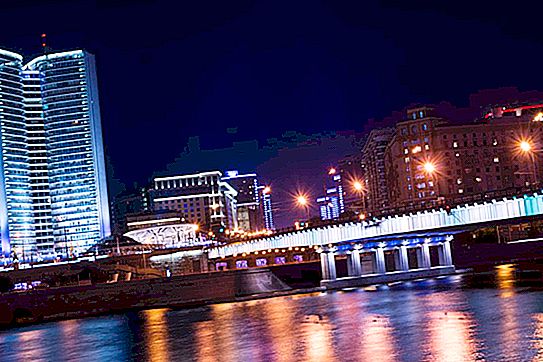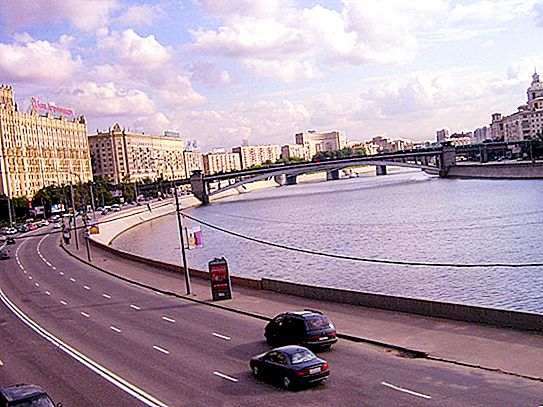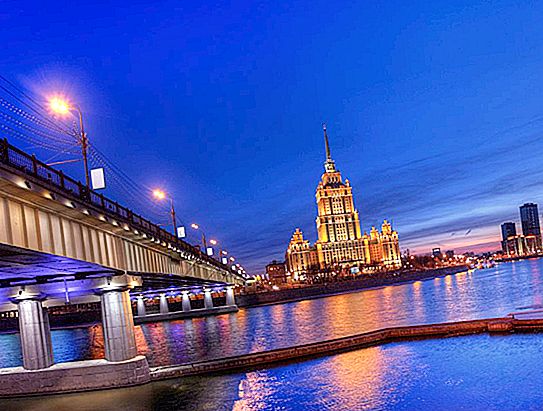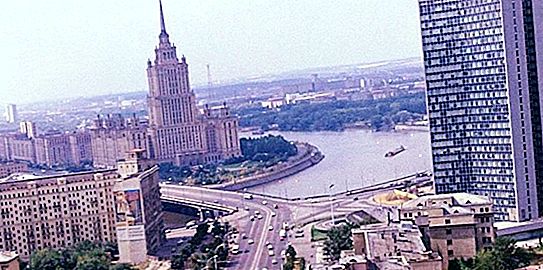Through the Moscow River, dividing the capital into two parts, a huge number of both automobile and pedestrian bridges were built. One of the most interesting and beautiful is Novoarbatsky, which connects Novy Arbat Street and Kutuzovsky Prospekt.
Locals advise visiting the bridge at night, when the buildings around are illuminated by hundreds of lights and reflected in the Moscow River - a truly impressive and, of course, romantic sight. At this time, you can make very beautiful photos from the Novoarbatsky bridge.

general information
The bridge is a rather impressive and large-scale construction.
The length of the Novoarbatsky bridge in Moscow is 494 meters. The bridge is designed for 8 car lanes. Also, public transport is organized along it.

Novoarbatsky bridge is one of the favorite walking routes of guests and residents of the capital. So beautiful views are opened from it that it is difficult to convey in words. Very often, sightseeing tours of Moscow include the Novoarbatsky bridge in their program and use it as an observation deck. Standing there, you can see several significant places of the capital. So, the first thing that catches your eye is the impressive building of the Government House. Looking at the panorama of Moscow from the Novoarbatsky bridge, one cannot but notice the building of the Stalinist skyscraper, in which the hotel "Ukraine" is located.

The bridge also offers stunning views of Novy Arbat Street, where a busy traffic stream does not subside day or night. Particularly mesmerizing is the view of the street at night - the headlights of passing cars form a light strip.
It is worth noting that many directors could not ignore the views that open from the Novoarbatsky bridge. So, this building can be seen in the film "Ivan Vasilyevich Changes the Profession".

History of Novoarbatsky bridge
The bridge was built in 1957. Initially, it was called Kalininsky. Only in 1993 did the bridge get its current name, by which it is known to all residents of the capital.
One very important historical event is connected with the Novoarbatsky bridge in Moscow. In 1993, the country escalated the confrontation between the legislative and executive branches, which gradually grew into an armed conflict. The president was a supporter of the early adoption of the new Constitution and the strengthening of presidential power, while representatives of the Supreme Council and the Congress of Deputies advocated maintaining the power of people's deputies. On October 3, 1993, President Boris Yeltsin introduced a state of emergency in the city. The next day, tanks were brought to the streets of the city, which reached the Novoarbatsky bridge and began shelling the White House. According to historical information, civilians were killed during the armed conflict.
Bridge construction
The authors of the Novoarbatsky Bridge project were a group of engineers from the Giprotransmost Institute. The main span is located at an angle of 72 degrees to the river bed. It is a steel-reinforced concrete beam.
During the design and construction of the Novoarbatsky bridge, for the first time in the practice of building Moscow bridges, steel spans were completely welded.
Each river bridge support consists of six columns, whose trunks are cut by vertical grooves, or flutes. The columns are located on a common caisson base, which prevents the occurrence of sediments or displacements that are unacceptable for the bridge structure. The supports located on the shore are piled, which can significantly increase the stability of the bridge and protects it from horizontal braking forces of cars, as well as deformation when temperatures change.




